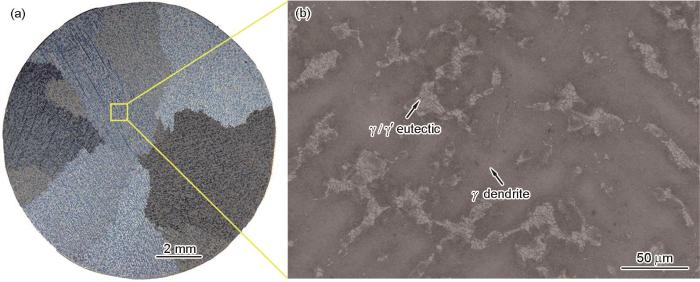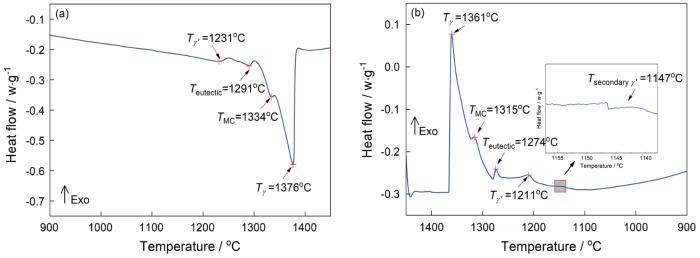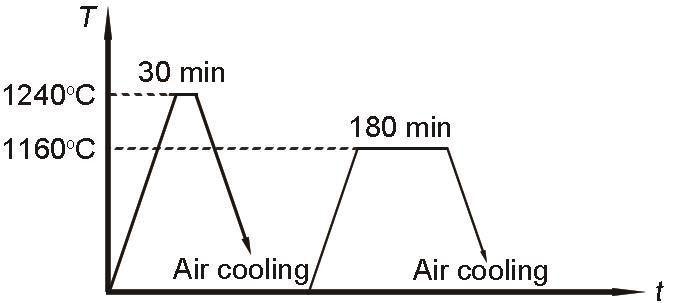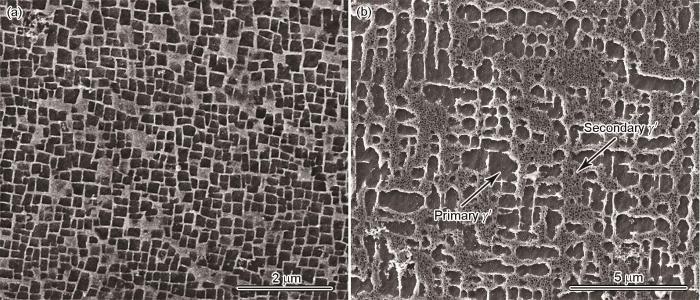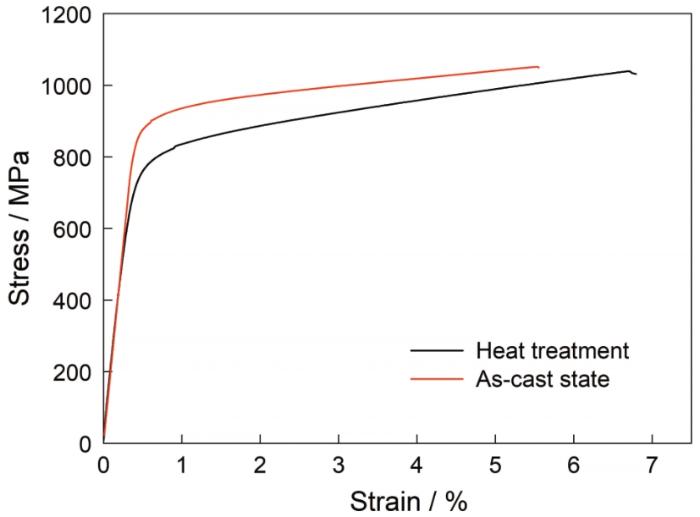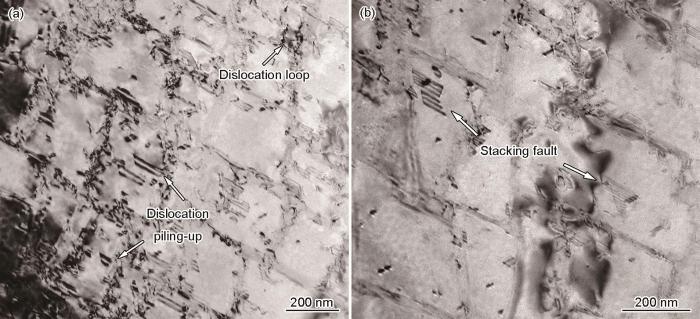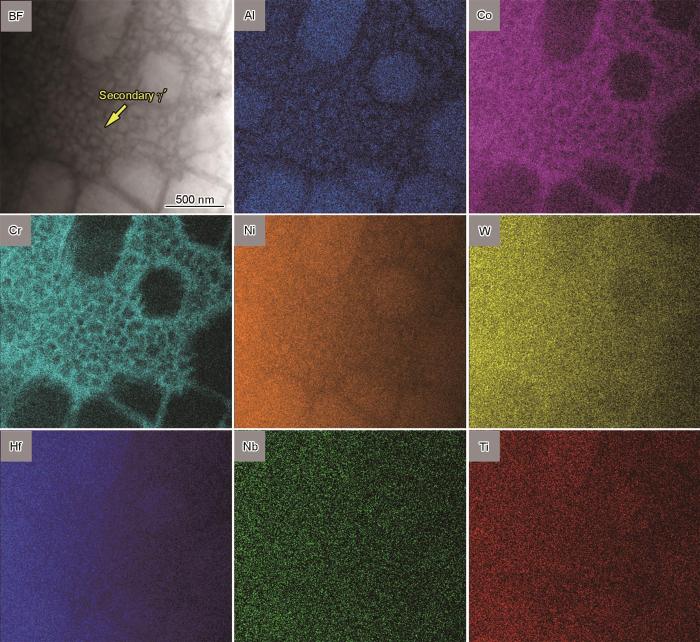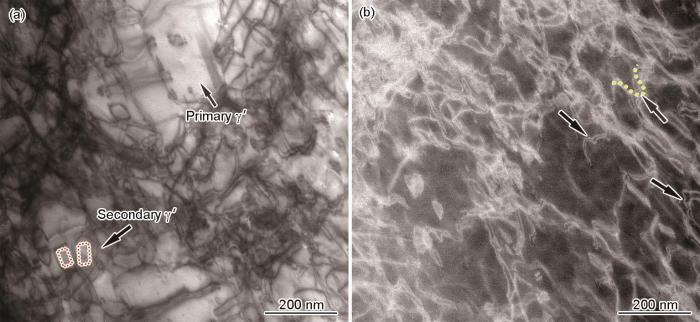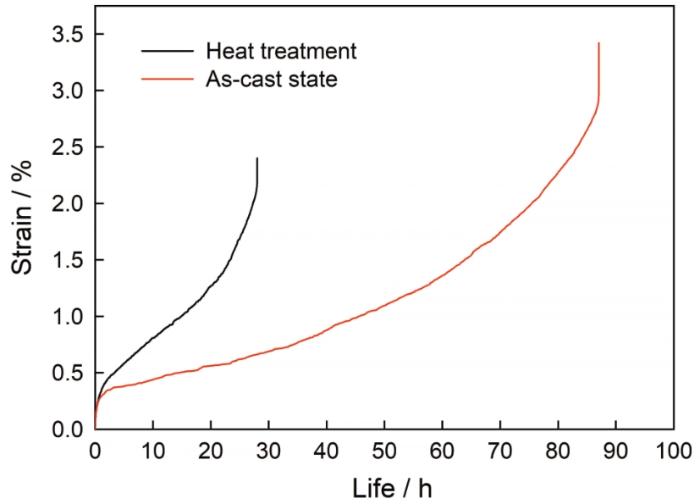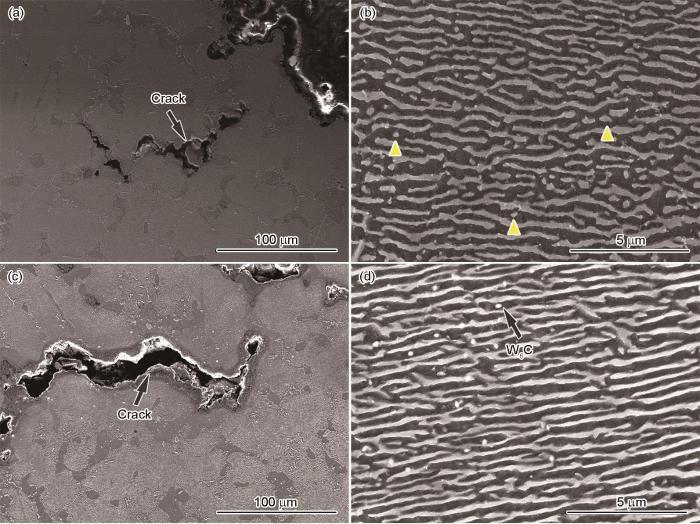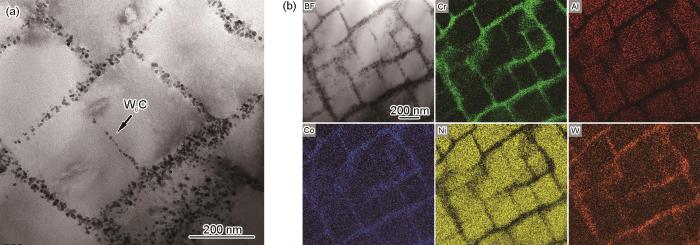镍基高温合金中的析出相主要有A1型γ基体和L12型γ΄有序相,皆为面心立方结构且有明显的共格关系[1]。γ΄相是镍基高温合金中最重要的强化相,其含量、形貌和尺寸都显著影响合金的高温力学性能[9, 10]。因此,在高温合金的变形过程中位错与γ΄相的交互作用极为重要。Wang等[11] 的研究表明,在室温拉伸过程中位错以层错的形式切入γ΄相并阻碍其他位错运动,使合金的屈服强度提高。Cui等[12]发现,M951G合金中的连续层错穿过γ΄相,促进了合金的加工硬化。Zhou等[13]报道,在高钨高温合金的高温拉伸过程中析出的纳米γ΄相颗粒有助于提高其高温强度。Xie等[14]指出,γ΄相在蠕变过程中发生定向粗化,位错在γ-γ΄界面形成密集的网状结构。这些研究结果表明,形貌和尺寸不同的γ΄相在合金变形过程中与位错的作用机制也不同。虽然对γ΄相与位错之间的关系研究得较多,但是在高温合金的服役过程中γ΄相对位错迁移机制的影响仍不明确。研究表明,在单晶高温合金的超温蠕变过程中析出的二次γ΄使其蠕变寿命降低[15]。而Guo等[16]发现,在K465合金的热循环蠕变过程中析出的二次γ΄相有助于阻碍位错运动而使起抵抗蠕变变形的能力提高。
1 实验方法
用VIM-F25型真空感应熔炼炉熔炼实验用K416B母合金锭,其主要化学成分(质量分数,%)为:C 0.1、Co 7.8、Cr 5.1、W 15.8、Al 5.8、Ti 0.8、Nb 1.7、Hf 1.1、Ni其余。
将母合金锭浇铸成型,制备等轴晶试棒。从铸态K416B合金试棒上切取直径为3 mm、厚度为2.5 mm的圆柱形试样,使用STA449F3型差热分析仪进行差示扫描量热分析(DSC),升降温速率为10℃/min。
为了调整合金中析出相的形貌,将合金在1240℃固溶30 min后空冷,再在1160℃时效3 h后空冷,使K416B合金中保留部分大尺寸γ΄相同时在γ相通道中析出细小的二次γ΄相。
将铸态和热处理态的K416B合金棒加工成标准拉伸(GB145-2001)和持久(GB/T 2039-2012)样品(图1)。标准拉伸样品的工作段长度为35 mm,直径为5 mm;标准持久样品的工作段长度为25 mm,直径为5 mm。用TSE504D型万能试验机进行拉伸测试。用F-25型蠕变/持久试验机进行持久测试,测试条件为975℃/235 MPa,用引伸计记录合金的变形。
图1
图1
拉伸试样和持久试样的加工示意图
Fig.1
Schematic diagram of mechanical test samples (a) tensile (b) durable (unit: mm)
将铸态、热处理态及其断裂后的纵剖面样品机械研磨、抛光后,用腐蚀剂5 g CuSO4+25 mL HCl+20 mL H2O进行化学腐蚀。用Stemi 508型光学显微镜(OM)和ZEISS MERLIN Compact场发射扫描电镜(SEM)观察不同状态合金样品的组织形貌。在距离断口5 mm处横向切取500 μm厚的透射电镜样品薄片,将其双面机械研磨至50 μm以下后进行冲孔得到直径为3 mm的圆片。将透射样品在-25℃进行双喷电解减薄,双喷液是体积分数为10%高氯酸乙醇溶液。用Tecnai G220透射电镜进行组织观察和位错分析。
2 实验结果
2.1 铸态合金的组织
图2给出了铸态K416B合金的晶粒和共晶组织的形貌。可以看出,合金的晶粒尺寸较大,平均尺寸约为3.5 mm。如图2b中的箭头所示,合金的枝晶间有大量的γ/γ΄共晶,是其在凝固过程中元素偏析所致。γ/γ΄共晶是高温合金中的非平衡组织,对其高温力学性能有不利的影响。图3给出了K416B合金的升温和降温过程DSC曲线。升温曲线上的四个特征温度分别对应合金中γ΄相的溶解温度,γ/γ΄共晶熔化温度,碳化物回溶温度和合金完全熔化温度(图3a)。在冷却曲线上出现了五个特征温度(图3b),在1147℃出现一个微弱的放热峰,是二次γ΄相的生成温度[21]。二次γ΄相,是在高温合金连续冷却过程中γ΄相在基体中多批次形核析出的。二次γ΄相属于后析出的γ΄相,析出温度较低,在γ通道中形核但是难以长大,因此其尺寸比初生γ΄相的小[22]。按照图4给出的合金固溶和时效热处理理制度,得到不同于铸态组织的、具有两种γ΄尺寸的K416B合金组织(图5)。从图5a可见,铸态K416B合金中γ΄相在枝晶干分布均匀,呈立方状,平均尺寸约为200 nm。图5b给出了K416B合金热处理后组织形貌,可见γ΄相尺寸迅速增大到1 μm左右,且其形状由立方状转变为长条状。另外,γ基体通道明显粗化,细小的二次γ΄相在γ基体通道中均匀析出。
图2
图2
铸态K416B合金的OM图像
Fig.2
OM micrographs of as-cast K416B alloy (a) low magnification, (b) high magnification
图3
图3
铸态K416B合金的DSC曲线
Fig.3
DSC results of as-cast K416B (a) heating, (b) cooling
图4
图5
图5
铸态和热处理态K416B合金中γ΄相的组织形貌
Fig.5
Morphologies of γ΄ phase in K416B (a) as-cast state, (b) heat treatment
2.2 K416B合金的拉伸性能
表1 K416B合金拉伸性能
Table 1
| Rp0.2 /MPa | Rm/MPa | A/% | Z/% | |
|---|---|---|---|---|
| As-cast | 936 | 1054 | 4.0 | 10.0 |
| Heat-treatment | 775 | 1040 | 6.5 | 11.0 |
图6
图6
γ΄结构不同的K416B合金的应力-应变曲线
Fig.6
Stress-strain curves of K416B alloy with different microstructures of γ΄
2.3 拉伸断裂后的组织形貌
图7
图7
γ΄结构不同的K416B合金的拉伸断口形貌
Fig.7
Fracture morphologies of K416B alloy with different microstructures of γ΄ (a, b) as-cast state; (c, d) heat treatment
图8
图8
γ΄相形貌不同的K416B合金拉伸断裂后的SEM照片
Fig.8
SEM images of K416B alloy with different microstructures of γ΄ after fracture (a) as-cast state, (b) heat treatment
图9给出了铸态K416B合金拉伸断裂后的TEM明场像。可以看出,室温拉伸断裂后位错在外力作用下形成了位错环(图9a)。另外,部分位错以位错对的形式切割γ΄相。图9b表明,部分切入γ΄的<110>超位错分解为层错。图10给出了热处理态K416B合金γ΄相的STEM-EDS图像,可见初生γ΄尺寸约为500 nm,细小的二次γ΄相在γ基体中析出。图10表明,Cr和Co元素偏析于γ基体,Al元素富集于γ΄相,而W元素在γ基体和γ΄相中等量分布。图11给出了热处理态K416B合金拉伸断裂后的TEM图像。由图11a可见,在室温拉伸期间合金基体中出现了位错塞积。大量全位错切入初生γ΄相,降低了合金的屈服强度。从TEM暗场相可观察到弯曲的位错组态(图11b),表明在合金变形过程中位错以Orowan机制绕过二次γ΄,并留下相应的位错环。
图9
图9
铸态K416B合金拉伸断裂后的TEM图像
Fig.9
TEM images of as-cast K416B alloy after tensile fracture
图10
图10
热处理态K416B合金的STEM-EDS图像
Fig.10
STEM-EDS images of heat-treatment K416B alloy
图11
图11
热处理态K416B合金拉伸断裂后的TEM图像
Fig.11
TEM images of heat-treatment K416B alloy after tensile fracture
2.4 K416B合金的持久性能
图12
图12
不同组织的K416B合金在975℃/235 MPa条件下的持久曲线
Fig.12
Durable rupture curves of K416B alloys with different morphologies under the condition of 975℃/235 MPa
2.5 持久断裂组织的形貌
图13给出了在975℃/235 MPa条件下铸态和热处理态K416B合金持久断裂后的显微组织。图13a、b给出了铸态K416B合金的断口纵剖面组织形貌,可见持久裂纹在枝晶间萌生并垂直于应力方向。图13b给出了合金断口处γ΄相的形貌。可以看出,γ΄相在持久过程中完全筏化并出现了拓扑倒置现象,如图中箭头所示。铸态K416B合金的筏形结构连续性差,分布不均匀。图13c、d给出了热处理态K416B合金断口的纵剖面组织形貌。与铸态相比,热处理态合金的枝晶间裂纹更加宽大(图13c)。这表明,合金热处理后裂纹易于在枝晶间扩展。图13d给出了合金断口处γ΄相的形貌,可见γ΄筏形的完整度高于铸态,在γ-γ΄界面还析出了碳化物颗粒。
图13
图13
铸态和热处理态合金在975℃/235 MPa条件下断口纵剖面的组织
Fig.13
Cross-sectional view of the alloys under the condition of 975℃/235 MPa (a, b) as-cast state; (c, d) heat treatment
图14
图14
K416B合金在975℃/235 MPa条件下断裂后的位错组态
Fig.14
Dislocation structures of K416B after rupture under 975℃/235 MPa
图15
图15
K416B合金在975℃/235 MPa条件下蠕变断裂后的STEM明场相和对应的能谱
Fig.15
STEM bright field image (a) and corresponding elemental mapping (b) of K416B after creep rupture under 975℃/235 MPa
3 讨论
3.1 γ΄ 相对K416B合金拉伸性能的影响
在含有高体积分数沉淀强化相的高温合金中,位错切过γ΄的临界应力小于Orowan绕过应力。研究表明,在奥氏体高温合金中位错通过γ΄的方式与γ΄尺寸相关[25]。在临界尺寸以下,位错以位错对的形式切入γ΄相。屈服强度位于刃型位错对和螺型位错对切割γ΄的理论强度之间,并随着γ΄相尺寸的增大而提高。γ΄相的尺寸超过临界尺寸后位错以Orowan机制绕过γ΄强化相,随着γ΄相之间距离的增大屈服强度的提高缓慢。本文的实验结果表明,在铸态K416B合金拉伸期间形变位错在基体通道中滑移,γ΄强化相有效阻碍了位错运动。位错塞积在γ-γ΄界面导致应力集中,少量位错以位错对的形式切入γ΄相。此外,K416B合金中W元素的含量较高使合金中γ΄相的层错能降低,<110>超位错在γ΄相中分解形成层错(图9b)。热处理后K416B合金的初生γ΄迅速粗化。与铸态K416B合金相比,在热处理态合金的拉伸变形过程中更多位错切入γ΄,使合金产生更大的塑性变形。这表明,γ΄相的强度随着其尺寸的增大而降低,阻碍位错运动的能力减弱。因此,热处理后K416B合金强度降低而延伸率提高。
3.2 γ΄ 相对K416B合金持久变形的影响
在持久变形过程中,合金中的位错密度逐渐提高。由于γ΄相的强度高于γ基体,基体的塑性变形量高于γ΄相,使γ基体和γ΄强化相界面处产生应力集中并出现密集的位错网络(图14)。在持久变形期间,合金中的γ΄相发生粗化。铸态K416B合金中的γ΄相在基体中均匀分布,发生筏化所需的时间更长,位错通过γ΄相需要更多的能量,因此铸态K416B合金的持久寿命可达90 h。与之相比,热处理态K416B合金的持久寿命仅为30 h,其大幅度下降可归因于:1)热处理后γ΄相的尺寸增大,γ基体通道的宽度也随之增大。在γ通道中析出了细小的二次γ΄相和元素扩散距离减小,使γ΄的筏化速率提高和合金抵抗变形的能力减弱。2)热处理后初生γ΄相尺寸的增大促进位错切入初生γ΄相,并提高了持久应变速率(图11)。因此可以观察到,热处理态K416B合金持久断裂后γ΄筏形更加完整(图13d)。形变位错切入初生γ΄相诱导颗粒状W6C在γ΄相中弥散析出(图15)消耗了大量的W元素,使γ-γ΄两相错配度减小,降低了合金的强化水平,导致持久寿命大幅度降低[26~28]。
4 结论
(1) K416B合金中γ΄相尺寸的增大使其屈服强度降低和延伸率提高。小尺寸二次γ΄相有助于提高合金的屈服强度,大尺寸初生γ΄相使其塑性提高。K416B合金的持久寿命随γ΄相尺寸的增大而下降。
(2) 在K416B合金的拉伸过程中产生的裂纹主要萌生于枝晶间区域。在铸态K416B合金的拉伸变形期间基体中形成高密度位错缠结,单根位错切入γ΄相并分解为层错,另有部分位错以位错对的形式切入γ΄相。在热处理态K416B合金中,在基体通道内滑移的位错受到二次γ΄的阻碍,位错以位错对或全位错的形式切入大尺寸γ΄相,以Orowan机制绕过二次γ΄相。
(3) 在热处理后的K416B合金中初生γ΄相的尺寸增大,使持久变形期间更多的位错切入γ΄相并促进颗粒状W6C析出。在γ通道中析出的二次γ΄相提高了合金的筏化速率,使热处理态K416B合金的持久寿命低于铸态。
参考文献
Microstructural evolution and compositional homogenization of a low Re-bearing Ni-based single crystal superalloy during through progression of heat treatment
[J].
Microstructural and compositional design of Ni-based single crystalline superalloys―A review
[J].
Investigation of solidification and segregation characteristics of cast Ni-base superalloy K417G
[J].Differential scanning calorimetry (DSC) analysis, isothermal solidification experiment and Thermo-Calc simulation were employed to investigate solidification characteristics of K417G Ni-base superalloy. Electron probe microanalysis (EPMA) was employed to analyze the segregation characteristics. Liquidus, solidus and the formation temperatures of main phases were measured. In the process of solidification, the volume fraction of liquid dropped dramatically in the initial stage, while the dropping rate became very low in the final stage due to severe segregation of positive segregation elements into the residual liquid. The solidification began with the formation of primary γ. Then with solidification proceeding, Ti and Mo were enriched in the liquid interdendrite, which resulted in the precipitation of MC carbides in the interdendrite. Al accumulated into liquid at the initial stage, but gathered to solid later due to the precipitation of γ/γ′ eutectic at the intermediate stage of solidification. However, Co tended to segregate toward the solid phase. In the case of K417G alloy, combining DSC analysis and isothermal solidification experiment is a good way to investigate the solidification characteristics. Thermo-Calc simulation can serve as reference to investigate K417G alloy.
Investigation on solidification path of Ni-based single crystal superalloys with different Ru contents
[J].
Influence of composition on microstructural parameters of single crystal nickel-base superalloys
[J].
Carbide evolution behavior of K416B as-cast Ni-based superalloy with high W content during high temperature creep
[J].As-cast Ni-based superalloys with high W content are used extensively in the turbine vane of aero-engine due to their good heat resistance and temperature capability. During high temperature service, the creep deformations and microstructure evolution are occurred in the using materials, and the creep behavior mainly depends on their chemical composition and microstructure, such as size, distribution and morphology of g ' phase and carbides. Thereinto, the mophologies of carbide phases are closely related to creep resistance of the alloy. Generally, the carbide particles displaying dispersive distribution may enhance the creep resistance of the alloy, while the carbide with continuous morphologies distributed in the boundaries, they may provide easy paths for crack propagation and degrade the mechanical properties of the alloy. Besides the creep life of the alloy also depends on the microstructure evolution under high temperature. But the evolution mechanism of carbides in K416B superalloy during creep is still unclear up to now. For this reason, by means of creep property measurement and microstructure observation, the evolution behavior of precipitates in K416B Ni-based superalloy with high W content during high temperature creep has been investigated. The results show that the size of g ' phase is inhomogeneous in the as-cast alloy, and the stripe MC-carbide distribute in the inter-dendrite regions displaying Chinese structures. During high temperature creep applied stress, fine M6C carbide discontinuously precipitate in the deformed g matrix. The thermodynamics analysis indicates that the carbon element segregates in the regions of stress concentration and combines with carbide-forming elements W etc, which promoted the fine M6C carbide to precipitate from the g matrix. At the same time, the grooves are formed on the surface of stripe MC carbide, and then gradually decomposed and transformed into M6C particles. Thereinto, the additional press formed in the surface of stripe MC carbide is the main factor to promote the MC phase continuous dissolution and spheroidizing.
高钨K416B铸造镍基合金高温蠕变期间碳化物演化行为
[J].
Coupling effects of tungsten and molybdenum on microstructure and stress-rupture properties of a nickel-base cast superalloy
[J].
The temperature dependence of γ′ volume fraction in a Ni-based single crystal superalloy from resistivity measurements
[J].
The effect of solid solution and gamma prime on the deformation modes in Ni-based superalloys
[J].
Tensile behaviors and deformation mechanisms of a nickel-base single crystal superalloy at different temperatures
[J].
Temperature dependence of tensile properties and deformation behaviors of nickel-base superalloy M951G
[J].
Effect of precipitates on high-temperature tensile strength of a high W-content cast Ni-based superalloy
[J].
Thermodynamics analysis and precipitation behavior of fine carbide in K416B Ni-based superalloy with high W content during creep
[J].
Constitutive modeling of the creep behavior of single crystal superalloys under non-isothermal conditions inducing phase transformations
[J].
High temperature creep behavior of a cast polycrystalline nickel-based superalloy K465 under thermal cycling conditions
[J].
Solidification behavior and segregation characteristics of high W-content cast Ni-Based superalloy K416B
[J].
Influence of W content on the microstructure of nickel base superalloy with high W content
[J].Nickel base superalloys are widely used in the preparation of hot end parts for aircraft engines because of their good comprehensive mechanical properties, oxidation resistance and structural stability. It's strengthened mainly by solid solution strengthening, γ' phase strengthening and carbide strengthening. High alloying is one of the main methods to improve the solid solution strengthening level of nickel base superalloys, where the element W is an efficient alloying element with low price. The control of the W content is extremely important for high W content nickel base superalloys. However, there are few reports on the influence of W content on the microstructure of high W alloy. According to this background, by means of OM, SEM observation and XRD analysis, the influence of W content on the solidified microstructure in nickel base superalloy have been investigated in this work. Results show that when the W content is about 14% (mass fraction, the same below), there is no α-W phase being precipitated in the alloy. While as the content of W is higher than 16%, α-W could be precipitated during the solidification. On another hand, the grain size of the alloy decreases from 1.04 mm to 0.17 mm and the volume fraction of eutectic increases from 6% to 10% with the increase of the W content. While the content of W has no obvious effect on the sizes and morphologies of γ' phase in the dendrite and inter-dendrite areas. During solidification, the α-W phase will be first precipitated due to its higher precipitation temperature, and the shrinkage of the residual liquid phase may cause the shift and growth of the α-W to the core of the liquid phase. The α-W could be as the core of the heterogeneous nucleation to reduce the critical nucleation energy, which is the main reason that the grain size of the 18%W alloy is smaller. During the growth of the dendrites with various orientations, the concentration of Al and Ti in the residual liquid phase may have a higher concentration gradient to cause the occurrence of eutectic transformation, which is the main reason that there is a higher volume fraction of eutectic in 18%W alloy.
W含量对一种高W镍基高温合金显微组织的影响
[J].通过OM、SEM和XRD对高W镍基高温合金进行组织观察与分析,研究了W含量对镍基高温合金凝固组织的影响规律。结果表明,当W含量为14% (质量分数,下同)时,镍基合金中无α-W相析出。当W含量高于16%时,合金凝固期间可析出α-W,并且随W含量提高,合金的晶粒尺寸由1.04 mm减小至0.17 mm,共晶含量由6%增至10%;W含量对在枝晶间/枝晶干内的γ'相尺寸及形态无明显影响。由于α-W的析出温度较高,在凝固期间首先析出,并在残余液相收缩作用下,α-W向液相核心处发生转移并长大;同时α-W可作为异质形核的核心,降低枝晶形核的临界形核功,使18%W合金获得较小的晶粒尺寸。此外,在不同取向枝晶汇聚生长的作用下,残余液相中Al、Ti等元素形成较高的浓度梯度而发生共晶转变,这是18%W合金中共晶含量较高的主要原因。
Influence of temperature on tensile behaviors of K416B Ni-based superalloy with high W content
[J].
B镍基合金拉伸行为的影响
[J].
Effect of long-term thermal exposures on tensile behaviors of K416B nickel-based superalloy
[J].
Microstructural evolution of a high W content Ni-based superalloy at γ' sub-solvus temperatures
[J].
Mechanisms related to different generations of γ' precipitation during continuous cooling of a nickel base superalloy
[J].
Tensile, creep behavior and microstructure evolution of an as-cast Ni-based K417G polycrystalline superalloy
[J].The Ni-based K417G superalloy is extensively applied as aeroengine components for its low cost and good mid-temperature (600-900 °C) properties. Since used in as-cast state, the comprehensive understanding on its mechanical properties and microstructure evolution is necessary. In the present research, the tensile, creep behavior and microstructure evolution of the as-cast K417G superalloy under different conditions were investigated. The results exhibit that tensile cracks tend to initiate at MC carbide and γ/γ′ eutectic structure and then propagate along grain boundary. As the temperature for tensile tests increases from 21 °C to 700 °C, the yield strength and ultimate tensile strength of K417G superalloy decreases slightly, while the elongation to failure decreases greatly because of the intermediate temperature embrittlement. When the temperature rises to 900 °C, the yield strength and ultimate tensile strength would decrease significantly. The creep deformation mechanism varies under different testing conditions. At 760 °C/645 MPa, the creep cracks initiate at MC carbides and γ/γ′ eutectic structures, and propagate transgranularly. While at 900 °C/315 MPa and 950 °C/235 MPa, the creep cracks initiate at grain boundary and propagate intergranularly. As the creep condition changes from 760 °C/645 MPa to 900 °C/315 MPa and 950 °C/235 MPa, the γ′ phase starts to raft, which reduces the creep deformation resistance and increases the steady-state deformation rate.
Ultrafast solution treatment to improve the comprehensive mechanical properties of superalloy by pulsed electric current
[J].
Strengthening mechanisms in γ' precipitating alloys
[J].
Formative and controlled mechanisms of nano-sized γ′ precipitates with local phase-transition within dislocation networks of nickel-based single crystal superalloys
[J].
The effect of chromium and cobalt segregation at dislocations on nickel-based superalloys
[J].
Influence of heat treatment regimes on microstructure and creep properties of FGH95 nickel base superalloy
[J].





